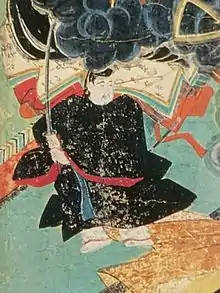Fujiwara no Tokihira | |
|---|---|
 | |
| Born | 871 |
| Died | 909 |
| Nationality | Japanese |
| Parents | Fujiwara no Mototsune (father) |
Fujiwara no Tokihira (藤原 時平, 871 – April 26, 909) was a Japanese statesman, courtier and politician during the Heian period.[1]
Career
Tokihira was a minister under Emperor Daigo.[1]
- 891 (Kanpyō 3, 3rd month): Tokihira was given a rank which was the equivalent of sangi.[2]
- 897 (Kanpyō 9, 6th month): Tokihira was made Dainagon with a rank equal to that of a General of the Left.[3]
- 899 (Shōtai 2): Tokihira was named Sadaijin[4]
- 900 (Shōtai 3): Tokihira accused Sugawara no Michizane of plotting against the emperor.[5] This led to Michizane's exile to the Dazaifu in Kyūshū.[6]
- 909 (Engi 9, 4th month): Tokihira died at age 39. He was honored with posthumous rank and titles.[7]
Genealogy
This member of the Fujiwara clan was the son of Fujiwara no Mototsune.[1] Tokihira had two brothers: Fujiwara no Tadahira and Fujiwara no Nakahira.[8]
- Father: Fujiwara no Mototsune
- Mother: Daughter of Imperial Prince Saneyasu
- Wife: Princess Renshi (廉子女王), daughter of Imperial Prince Motoyasu
- 1st Son: Fujiwara no Yasutada (藤原保忠; 890-936)
- Daughter: Fujiwara no Hōshi (藤原 褒子), consort of Emperor Uda
- Daughter: Fujiwara no Hitoshi (藤原 仁善子)
- Wife: Daughter of Minamoto Jin
- 2nd Son: Fujiwara no Akitadata (藤原顕忠; 898-965)
- Wife: Daughter of Ariwara no Muneyana
- 3rd Son: Fujiwara no Atsutada (藤原敦忠; 906-943)
- Wife: Unknown
- Daughter: Concubine of Fujiwara no Saneyori
- Daughter: Wife of Imperial Prince Atsumi
- Daughter: Wife of Imperial Prince Yoshiakira
Selected works
In a statistical overview derived from writings by and about Fujiwara no Tokihira, OCLC/WorldCat encompasses roughly 35 works in 69 publications in 1 language and 122 library holdings.[9]
See also
Notes
- 1 2 3 4 5 Nussbaum, Louis-Frédéric. (2005). "Fujiwara no Tokihira" in Japan Encyclopedia, p. 210, p. 210, at Google Books; Brinkley, Frank et al. (1915). A History of the Japanese People from the Earliest Times to the End of the Meiji Era, p. 203., p. 203, at Google Books
- ↑ Titsingh, Isaac. (1834). Annales des empereurs du japon, p. 127., p. 127, at Google Books; see "Fousiwara-no Toki fira", pre-Hepburn romanization
- ↑ Titsingh, p. 129., p. 129, at Google Books
- ↑ Titsingh, p. 130., p. 130, at Google Books.
- ↑ Brinkley, p. 244., p. 244, at Google Books; excerpt, "...three principal contrivers of Michizane's disgrace [were] Fujiwara Tokihira, Fujiwara Sugane, and Minamoto Hikaru ...."
- ↑ Brinkley, p. 249., p. 249, at Google Books; excerpt, "From one point of view, Michizane's overthrow by Fujiwara Tokihira may be regarded as a collision between the Confucian doctrines which informed the polity of the Taika epoch and the power of aristocratic heredity."
- ↑ Titsingh, p. 132., p. 132, at Google Books.
- ↑ Brinkley, p. 241., p. 241, at Google Books
- ↑ WorldCat Identities Archived December 30, 2010, at the Wayback Machine: 藤原時平 871-909
References
- Brinkley, Frank and Dairoku Kikuchi. (1915). A History of the Japanese People from the Earliest Times to the End of the Meiji Era. New York: Encyclopædia Britannica. OCLC 413099
- Nussbaum, Louis-Frédéric and Käthe Roth. (2005). Japan encyclopedia. Cambridge: Harvard University Press. ISBN 978-0-674-01753-5; OCLC 58053128
- Titsingh, Isaac. (1834). Nihon Odai Ichiran; ou, Annales des empereurs du Japon. Paris: Royal Asiatic Society, Oriental Translation Fund of Great Britain and Ireland. OCLC 5850691
This article is issued from Wikipedia. The text is licensed under Creative Commons - Attribution - Sharealike. Additional terms may apply for the media files.